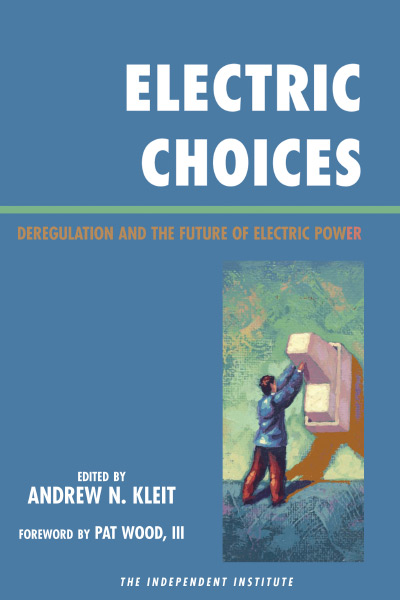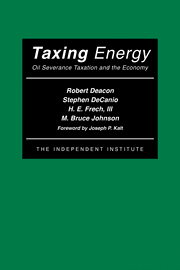| List Price: | $80.00 |
| List Price: | $80.00 |
Overview
Electricity is one of the biggest industries in the U.S. economy, with sales exceeding $200 billion annually. While electricity represents the backbone of commerce, industry, and household production, the structure of the industry has been changing in rather dramatic ways. After being heavily regulated for more than a century by local, state, regional and federal authorities, deregulation is taking center stage.
In general, deregulation results in lower prices, more product choices, and more rapid technological advances. Conversely, rate regulation has inherent flaws, including the encouragement of waste and inefficiency, and a retarding of innovation. There is little doubt to the contributors of this book that putting regulation aside offers enormous efficiency gains in the production of electricity.
But can forces handle the delicate matter of transmitting electricity when the simple model of supply and demand must be more precise than other goods and services? How much regulation does the electric industry need? Electric Choices explores these difficult questions and proposes a new, market-based plan to improve America’s electrical future.
Contents
Foreword
Pat Wood, III
1. Introduction
Andrew Kleit
2. Can Electricity Restructuring Survive? Lessons from California and Pennsylvania
Andrew Kleit and Timothy Considine
3. The Role of Retail Pricing in Electricity Restructuring
Lynne Kiesling
4. Using Experiments to Inform the Restructuring of the Electricity Industry
Vernon Smith, Steven Rassenti and Bart Wilson
5. The Alberta Experience
Joseph Doucet, Andre Plourde and Terry Daniel
6. Transactions Costs and Organization of Coordinated Activities in Power Markets
Craig Pirrong
7. Market-Based Transmission Investments and Competitive Electricity Markets
William Hogan
8. Checking for Market Power in Electricity: The Perils of Price-Cost Margins
Timothy Brennan
9. The Role of Distributed Energy Resources in a Restructured Power Industry
David E. Dismukes
10. Blackout Economics
Lynne Kiesling and Michael Giberson
Detailed Summary
- Electricity restructurings are not all the same: California and Pennsylvania restructured their electricity sectors in the late 1990s but had very different results. Whereas California in 2000–2001 suffered blackouts, sharply higher prices, and utility company bankruptcies, Pennsylvania has enjoyed reliable supply at relatively low and stable prices. The California crisis brought restructuring to a halt, but it should have prompted policymakers to look more closely at differences in restructurings.
- Lower prices: The benefits of a well-designed restructuring are substantial. By the end of the 1990s restructuring had lowered long-run costs by at least $7 billion, achieved by a more efficient use of capital, fuel, labor and maintenance. In areas with excess capacity and a competitive market, these lower costs push down electricity rates.
- Increased consumer choice: Restructuring eliminates the monopoly on retailing held by local distribution companies. In a properly restructured market, consumers can choose their electricity producer just as they select their long-distance provider. In addition to lower prices and greater efficiency, this competitive environment can improve reliability and quality, which would be especially welcomed by computer server farms and high-tech manufacturers. Customers can have even more options if restructuring invites Distributed Energy Resources (fuel cells, microturbines, wind turbines, photovoltaics, etc.), which enable customers to meet their own energy needs and to sell any surpluses over the power grid.
- Prices send signals: When California suffered electricity shortages in 2000–2001, consumers had no incentives to use less: caps on retail prices had sent them the wrong signals. Prices caps served to bankrupt utilities and strain the electrical grid. In contrast, variable prices would have given consumers incentives to seek out the best power supply contracts for themselves, as well as to reduce demand during periods of high prices.
- No more blackouts! Over 50 million customers in the U.S. and Canada were hit by the $6 billion Northeast blackout of August 14, 2003. The government’s final report accurately diagnosed the causes, but its forty-six recommendations were misguided because they emphasized greater regulatory oversight and centralization—policies that fail to enhance the system’s resiliency, flexibility, and adaptability. Genuine reliability must reflect consumer demand for reliability, as well as technical improvements on the supply side.
In the late 1970s, the regulatory landscape in the United States began to change significantly as competition and deregulation were introduced to telecommunications, airlines, trucking, natural gas and oil transportation, financial services, and other industries—with impressive results. Competition increased, the pace of innovation accelerated, prices fell, and the reforms were viewed as successful. Economic restructuring and liberalization eventually came to the electric power industry but in a more piecemeal fashion.
The results have prompted a host of questions from policymakers and the public: What lessons can be learned about the successes and failures of past restructurings? How much regulation does the electric industry need? Are coordination and distribution best handled public or privately? If the latter, would for-profit or non-profit organizations better serve consumers? In Electric Choices: Deregulation and the Future of Electric Power, edited by Andrew N. Kleit (Pennsylvania State University), fifteen leading experts address these and other key issues that will determine whether electricity will become cheaper and more reliable, or more expensive and prone to blackouts.
Lessons to Learn
The Public Utilities and Regulatory Policy Act of 1978 allowed independent producers to sell electricity to utilities. New producers quickly arrived on the scene, disproving the idea that electricity generation was a natural monopoly. Passage of the Energy Policy Act of 1992 eventually forced utilities with transmissions networks to deliver power to third parties at nondiscriminatory cost-based rates. It also prompted several state utility commissions to disaggregate retail prices into generation, transmission, distribution, and transition charges.
In the mid-1990s California, Pennsylvania, Texas, and smaller states in the Northeast embarked on electricity restructuring, i.e., they opened up that sector to competition. The results varied widely. At one end of the spectrum, Pennsylvania’s restructuring was viewed as successful. On the other end, California’s electricity crisis of 2000– 2001 brought the restructuring movement to a halt, leaving electricity markets at the retail level half deregulated and half regulated.
In Chapter 2, Andrew Kleit and Timothy Considine (Pennsylvania State University) compare restructuring efforts in California and Pennsylvania. They find that even if California had not deregulated its electricity industry, it would have faced higher electricity prices for several reasons, including a shortage of generation capacity and bottlenecks in producing and delivering additional natural gas supplies for power generators.
Lynne Kiesling (Northwestern University) examines the retail side of the industry in Chapter 3. She contends that the “one size fits all” approach of regulated and fixed rates is becoming increasingly obsolete due to technological, institutional, regulatory, and cultural changes. Retail reform would not only promote a more efficient electricity market directly, it would also promote it indirectly by helping to maximize the value of other market reforms.
In Chapter 4, Stephen Rassenti, Vernon Smith, and Bart Wilson (all of George Mason University) review the use of experimental economics to inform the debate on electricity market regulation. The studies reviewed demonstrated in practical terms how electricity markets could be divided into transmission, system operation, and marketing, laying the groundwork for practical restructuring in the 1990s. In particular, experimental economics (a field for whose development Vernon Smith won a Nobel Prize) show that the use of demand-side bidding for a relatively small fraction of the market can serve to reduce price spikes and the exercise of market power. Demand-side bidding would also ease the need (or the perceived need) for price caps in many regions. Similar experimental results also show how competitive transmission markets can be constructed.
In Chapter 5, Terry Daniel, Joseph Doucet, and Andre Plourde (all of University of Alberta) examine the successful, but often overlooked, restructuring experience in the Canadian province of Alberta. This restructuring creates an ideal test case study for policy analysis. In addition, several aspects of Alberta’s electricity restructuring are unique, interesting, and merit consideration.
Economies of Scale
In Chapter 6, Craig Pirrong (University of Houston) asks how far decentralization can go in power markets. He analyzes the costs and benefits of decentralization in power markets by using the tools of transactions-costs economics. His basic conclusion is that complete decentralization is infeasible in power markets owing to the physical characteristics of power transmission systems. Reliable operation of a power system is a public good, which creates well-known collective action problems that need to be mitigated, he argues.
Another difficult issue for electricity restructuring is transmission. The common wisdom on transmission is that because it exhibits economies of scale, it is not subject to restructuring. William Hogan (Harvard University), the leading writer in this area, takes issue with this view in Chapter 7. To enhance entry into transmission markets, Hogan suggests that owners of new transmission be able to restrict access across their lines in order to capture monopoly profits. Although this proposal is consistent with standard antitrust law, it is in conflict with Federal Energy Regulatory Commission (FERC) policy, which calls for open and complete access to such facilities.
Competition and Concentration
Successful restructuring plans will seek to limit any opportunities for firms to exercise “market power,” i.e., pricing advantages that leading firms have when operating in markets with relatively few competitors and significant barriers to entry. In Chapter 8, Timothy Brennan (University of Maryland, Baltimore County) argues that most empirical studies of market power in electricity rely on a flawed application of a standard measure of market power—the Lerner index. Flawed measures could lead, and perhaps already have led, regulators to prevent sales of electricity above the highest average variable cost of the generators used to provide electricity. Preventing at least some firms from earning revenues in excess of their average variable costs will encourage present suppliers to leave the market and discourage new firms from entering. Without such entry, competitive electricity markets are likely to fail.
The standard model of electricity competition is a relatively large generation plant, sending electricity through a natural monopoly distribution system to customers. What if, instead, a substantial number of customers could produce their own power? David Dismukes (Louisiana State University) explores this possibility in Chapter 9, outlining the prospects for distributed energy resources (DER). DER refers to generation, storage, and demand-side management devices that are connected to the electric grid at the distribution level. In many instances, DER can provide the electricity consumer with greater reliability, higher power quality, and more flexible choices.
Preventing Blackouts
In Chapter 10, Lynne Kiesling and Michael Giberson (George Mason University) review the U.S.-Canada Power System Outage Task Force's Final Report on the Northeast American blackout of August 14, 2003. The report recommended policies based almost entirely on an engineering and regulatory approach. Kiesling and Giberson, in contrast, make the case for pursuing a more economically sophisticated approach to industry restructuring. They focus on the possibility of commercializing reliability by reforming the reliability rules to properly align incentives and information flows.
•••
Opening electricity generation to competition sparked a revolution in the electricity industry, but for the benefits to be fully realized, restructuring must proceed with greater attention paid to incentives, consumer preferences, and system-wide flexibility. Pat Wood III, former Chairman of FERC, writes in the foreword to the book, “The superb and very timely analysis and recommendations in Electric Choices will help us to finish the revolution.” Completing that task would ensure a bright future for electric power and its users.
Praise
“This excellent book provides an agenda out of the impasse the U.S. has found itself following the California energy debacle and the wider crisis in electric power. Electric Choices is a must read.”
—Pablo T. Spiller, Professor of Business and Technology, University of California, Berkeley
“Recommended Reading on Energy: Numerous lessons can be learned from the electricity deregulation debacle in California and elsewhere. Electric Choices thoroughly examines these cases to help readers learn from those mistakes. It provides an excellent synthesis of the current perspectives that shape the national debate on electricity restructuring.”
—Wall Street Journal
"Electric Choices should be mandatory reading for anyone interested in the electricity industry, and who want to learn from the mistakes California made. These leading experts explain why and how well-run markets are the best deal electricity customers are going to find."
—G. Mitchell Wilk, former President, California Public Utilities Commission
“Electric Choices, edited by Andrew Kleit, is a book that makes a strong case that our electric power industry could be significantly more consumer-friendly, reliable, and efficient if it were guided more by the invisible hand of the market than the all-too-visible and usually clumsy hand of state and federal regulation. . . . The book gives the reader a comprehensive look at our electrical generation and transmission systems, with special emphasis on the inefficiencies of state and federal regulation. . . . [This is] a book packed with insights into the problems with our current mode of electricity regulation and the possibilities for a brighter future if we can break through the inertia that protects the status quo. Since that inertia is at least partly rooted in the fact that few people have ever considered the benefits we would derive from an electricity market with far less government control, Professor Kleit’s eye-opening book is extremely welcome.”
—Regulation
“Electric Choices is a first-rate book featuring some of the nation's leading energy analysts and belongs on the bookshelf of every scholar, policy wonk and utility executive.”
—Ahmad Faruqui, Principal, The Brattle Group
“Electric Choices provides convincing theoretical, experimental, and empirical support for forging ahead to achieve efficiencies that will not come about in a regulated environment where utilities expect to recover their costs-plus profit and have few incentives to respond energetically to customer demand.”
—Peter M. Schwarz, Global Institute of Energy and Environmental Systems, University of North Carolina at Charlotte
“Electric Choices, with the Independent Institute as the driving force behind this edited volume, is in the pro-market wing of the pro-restructuring camp. The editor, in his introduction, presents a balanced and qualified case for restructuring, acknowledging both its opportunities and challenges. . . . Electric Choices has some interesting and thought-provoking chapters, accessible to specialists and generalists alike.”
—The Energy Journal
“Electric Choices is a superb book that addresses what we have learned from restructuring experiences to date and presents important methods from economics with which to analyze these basic questions."
—Peter Cramton, Professor of Economics, University of Maryland
“There is no better way to summarize A. Kleit's book than by its title, Electric Choices. 'Choice' is indeed the fil rouge of all contributions—choice by consumers, by electric utilities, by regulators and by investors—in the interests of achieving a liberalized and efficient electricity market. The book refers mainly to the U.S. experience and summarizes the milestones of U.S. electricity sector reform, with its successes and failures. The lessons learned are of crucial importance for E.U., in the aftermath of the full opening of the market, as well as the release of the third liberalization package that accelerates sector’s reform. . . . The book is well written, though the topics are very classical ones. . . . Those who look to a comprehensive overview of key points in the electricity reform debate should read this book, which succeeds in surveying relevant work on each of the topics considered.”
—Economica
“The excellent book, Electric Choices, describes the promises of electricity deregulation, the mistakes made in the past, and the path to workable competition in this industry. Highly recommended.”
—Richard J. Gilbert, former U.S. Deputy Assistant Attorney General; Professor of Economics, University of California, Berkeley
“Electric Choices brings together superb analyses of the current state of play by some of the most important contributors to the on-going restructuring debate in the United States. The book provides a readable and stimulating assessment of what has worked, and what hasn't worked, in restructuring thus far. In doing so, the book provides a set of arguments from various perspectives to support its main thesis that developments in technology and market governance now, more than ever, allow and require that we move beyond the balkanized interests that have been delaying competition to garner the immense benefits of competition in wholesale and retail power markets.”
—Paul R. Kleindorfer, Anheuser Busch Professor of Management Science Emeritus, University of Pennsylvania; Distinguished Research Professor, INSEAD
“Passage of the Public Utilities and Regulatory Policy Act (PURPA) in 1978 paved the way for deregulation of the electrical power industry because it allowed small, independent power producers to sell electricity to utilities for marginal costs. As a result, PURPA, as observed by the editor, Andrew Kleit, 'demolished the intellectual idea that electricity generation was a natural monopoly that required regulated prices and entry.' . . . In . . . Electric Choices, Kleit and fourteen other energy analysts and scholars analyze 'the benefits of a well-designed restructuring program: lower prices, increased consumer choices, and reliable supplies; as well as challenges: electricity is not storable, is currently transmitted through a natural monopoly distribution system, and there is resistance to real-time pricing.'”
—Natural Resources and & Environment
"If one accepts the premise that the current underlying conditions of electricity systems are untenable in the long run, then one is left . . . . to learn from others’ successes and failures in the restructuring and deregulation of their electricity sectors. Supporters of this approach will find much food for thought in Electric Choices, a collection of jargon- and ‘Greek letter-’ free essays edited by Pennsylvania State University economist Andrew Kleit. As can be expected from a book published by the Independent Institute, the various authors do not ask whether the electricity sector should be deregulated, but rather how it should be. . . . In short, the authors argue that not all electricity restructuring experiences were the same (if California was a disaster, Pennsylvania proved that it could work); that deregulation can deliver lower prices, a better use of scarce resources and increased consumer choice; that a working price system will send the right signals to both consumers and investors; and that blackouts will be a thing of the past in freer markets. . . . . These are contributions penned by and for serious students of energy markets. As the editor points out, electricity markets are extremely complicated, and the book’s content reflects this reality.”
—Canadian Geographer
Author
Andrew N. Kleit is Professor of Energy and Environmental Economics at Pennsylvania State University and has been an economist with the President’s Council of Economic Advisors and the Federal Trade Commission.
About the Foreword Author
Pat Woods III is the former Chairman of the Federal Energy Regulatory Commission.















